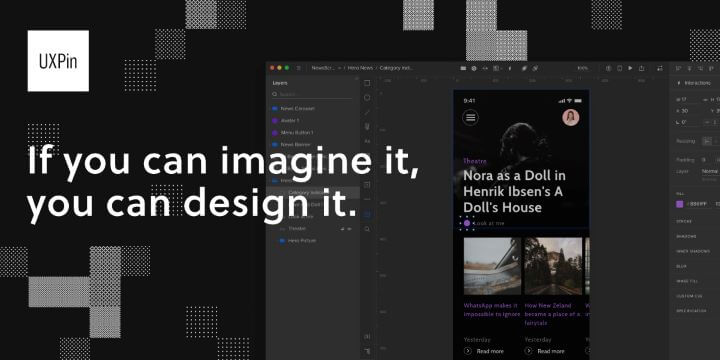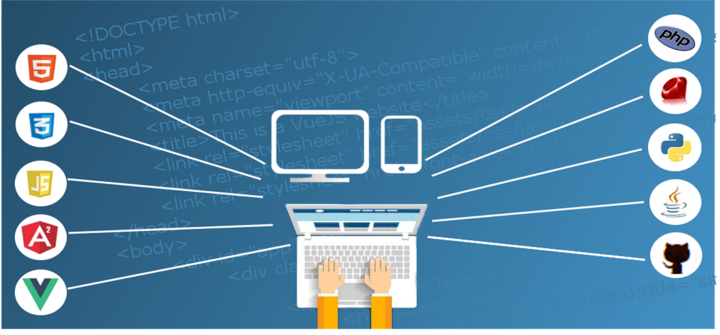Why switch from Image-based to Code-based design?
There has been a big issue since the dawn of the digital product design. Designers are separated from the product development process and are forced to work only with software.
Table of Contents
The designers use raster graphics or vector design tools to draw pictures as they are siloed from the rest of the organization. The process in most cases remains identical even if they work in different software like Photoshop, Gimp, Sketch, or Fireworks. A set of static images is sent to the engineers as the intent rendered by the designers.
It is extremely tedious to show different states of the interface through static art boards. Hence everything is not detailed by the designers.
And eventually, the whole user interface is built by the engineers with the help of a set of incomplete static images. Often in a lengthy back and forth communication, all the interactive states are usually ironed out.

The experience is not represented accurately with static designs and hence the tests are usually tiresome for the users. It is due to these inefficient processes that an organization leads to unsuccessful products and frustrated teams.
Thanks to the evolution in technology today we have a better way to design things. Image-based design tools are being rapidly replaced by code-based design tooling paradigm.
Static representations of the design drawn from vector design tools or raster are replaced with rendered designs where designers intent it directly in the code without actually knowing how to code.
A new workflow is provided by the new set of tools where:
• Designers and Engineers both establish a single source of truth
• Without any coding experience, it empowers designers with the full power of coding
• The duo of designers and engineers are connected through a single collaborative creative process which creates a spectacular workflow evolution
Image-based to Code-based Design with UXPin
The first and basic question here is what is not good or inefficient with the image-based design before making the transition from Image-based to Code-based design. You might be well aware that there two paradigms of design tooling i.e. code-based and image-based design tools.
An image-based design tool is an approach which has been used for many decades and is considerably old. The designers have to build vector or raster graphics when they draw something which is the idea of this tools approach.
With this approach, the designers have maximum flexibility. From advanced illustrations to simple icons everything can be effectively drawn this way including the most beautiful level of details. Although when it comes to professional digital product development it usually breaks. Here is the reason why it happens.
1. Lacking Interoperability: The actual interface of a product except for photographs, illustrations, and icons are never build with these graphics. Designers work outside of the constraints set up in code when working on interface design in image-based design tools. Due to this, they can create things that are expensive to code and the ones which are difficult in an unknown manner.
2. Lacking Accuracy: Apart from creating wonderful designs which are detailed, the most inaccurate results during the development process is often with image-based tools. The designer’s work is rendered with completely different process.
Therefore, there is a difference in the code of gradients, text, and color chosen by a designer and that by an engineer even with the application of the same specs. The teams are affected by massive misalignment because of this.
3. Static Design: The workflow focus on image-based design tool is on building static artboards for all the states of the interface which are eventually linked together. For professional projects, this is a break-in approach. In the static window, the simplest of patterns become like a dropdown which is unmanageable.
This happens because of the lacking ability to preserve interactive components for reusability and due to a considerably large amount of artboards. On top of all these tools permit only basic interaction without the ability to set variables for content, states of elements, conditional logic, and others.
4. Weak collaboration in design-engineering: The engineering process is completely different from this tool and cannot be merged. The output of both worlds is disconnected from its very nature.
Technologies used by the users are the final product of the developers work while additional layers of abstraction which are far away from the final user experience are introduced by image-based design.
Designers and engineers are disconnected and frustrated with one another because of reusable interactive components, lack of real interactions, and the ability to import connections from code.
Uniqueness in code-based design
It is important to know what is special in this design as we are emphasizing on the transition of Image-based to code-based design. When a user draws something using a code-based design tool it creates relevant CSS/HTML/JS and engages the browser. This renders the engine to show results visually.
Following are the benefits to designers after their transition from Image-based to code-based design.
1. Fidelity: There is a one-hundred per cent match between the intent of a designer and a code-able result when one uses a code-based design. To render all the design projects the technology used in the code-based design is the same as that of web development.
2. Eliminates constraint difference amongst designers and developers: Things that are difficult to design and are impossible to recreate in code can be created by the designers in image-based tools. These exact same constraints are applicable for both designers and developers in code-based tools. Hence it ensures that both designers and developers remain in sync.
3. Substituting art boards with interactive components: Instead of linked art boards, code-based design tool uses the most advanced interactions on the components. This approach directly empowers designers to create highly reusable interactive design systems and it also mimics development.
4. Realistic and Powerful interactions: With the transition from Image-based to code-based designs objects can interact with each other, move on the screen, and create complex patterns. It does not require one to know how to code which is most important for collaboration with engineers and testing with users.
5. Creates the strongest collaboration ever: A completely new, revolutionary approach to the engineering and design collaboration is achieved through code-based paradigm.


